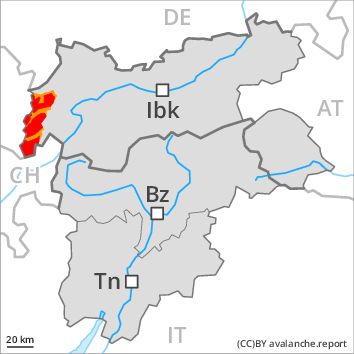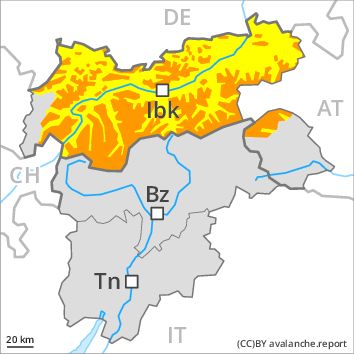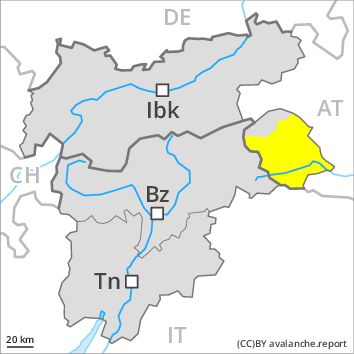Regions
Western Lechtal Alps, Western Verwall Mountains, Silvretta

Danger level
Danger Level 4 - High above 2000m
Danger Level 3 - Considerable above 2000m
Avalanche Problem
Wind-drifted snow above 2000m, N-NE-E-SE-S-SW-W-NW
Wet snow, N-NE-E-SE-S-SW-W-NW

The snow sport conditions outside marked and open pistes are dangerous. High, level 4. More frequent natural avalanches are to be expected.
The snow sport conditions outside marked and open pistes are dangerous. Single winter sport participants can release avalanches very easily, including large ones. This applies in particular above approximately 2000 m in all aspects. As a consequence of warming during the day and the solar radiation, the likelihood of slab avalanches being released will increase appreciably on steep sunny slopes.
As the day progresses more natural moist avalanches are to be expected. This applies in particular on very steep sunny slopes. The avalanches can be released in the various layers of fresh snow and reach large size in isolated cases. Snow sport activities outside marked and open pistes call for very extensive experience in the assessment of avalanche danger and great restraint.
Snowpack
dp 6: cold, loose snow and wind
dp 10: springtime scenario
30 to 50 cm of snow, and even more in some localities, fell. This applies above approximately 2000 m. At low and intermediate altitudes the snow is moist. The sometimes strong wind will transport the fresh snow. Over a wide area fresh snow and wind slabs are lying on soft layers. This applies in all aspects above approximately 2000 m. The older wind slabs have bonded quite well with the old snowpack. In very isolated cases weak layers exist in the old snowpack, in particular in areas where the snow cover is rather shallow.
Tendency
The avalanche danger will decrease.
Regions
Weißkugel Range, Gurgler Range, Central Stubai Alps, Eastern Verwall Mountains, Northern Zillertal Alps, Allgäu Alps, Venediger Range, Samnaun Mountains, Eastern Lechtal Alps - Ammergau Alps, Northern Oetz and Stubai Alps, Mieming Mountains, Western Tuxer Alps, Karwendel Mountains, Eastern Tuxer Alps, Brandenberg Alps, Western Kitzbühel Alps, Wilder Kaiser Mountains - Waidring Alps, Eastern Kitzbühel Alps, Central Lechtal Alps, Glockturm Range, Grieskogel Mountains

Danger level
Danger Level 3 - Considerable above 1500m
Danger Level 2 - Moderate above 1500m
Avalanche Problem
Wind-drifted snow above the treeline, N-NE-E-SE-S-SW-W-NW
Wet snow, N-NE-E-SE-S-SW-W-NW

The snow sport conditions outside marked and open pistes are to some extent precarious. More frequent natural avalanches are to be expected.
The snow sport conditions outside marked and open pistes are to some extent precarious. Single winter sport participants can release avalanches easily, including medium-sized ones. This applies on steep slopes above the tree line. As a consequence of warming during the day and the solar radiation, the likelihood of slab avalanches being released will increase appreciably on steep sunny slopes.
As the day progresses a large number of small and, in isolated cases, medium-sized natural moist avalanches are to be expected. The avalanches are shallow. Snow sport activities outside marked and open pistes call for extensive experience in the assessment of avalanche danger and caution.
Snowpack
dp 6: cold, loose snow and wind
dp 10: springtime scenario
10 to 30 cm of snow, and even more in some localities, fell. This applies above approximately 2000 m. Up to intermediate altitudes rain has fallen. At low and intermediate altitudes the snow is moist. The sometimes strong wind will transport the fresh snow. Over a wide area fresh snow and wind slabs are lying on soft layers. This applies in all aspects above the tree line. The older wind slabs have bonded quite well with the old snowpack. In very isolated cases weak layers exist in the old snowpack, in particular in areas where the snow cover is rather shallow.
Tendency
The avalanche danger will persist.
Regions
Glockner Range, Eastern Deferegger Alps, Schober Mountains, Lienzer Dolomites, Eastern Rieserferner Mountains
AM

Danger level
Danger Level 2 - Moderate above 2200m
Danger Level 1 - Low above 2200m
Avalanche Problem
Wind-drifted snow above 2200m, N-NE-E-NW
PM

Danger level
Danger Level 2 - Moderate above 2200m
Danger Level 2 - Moderate above 2200m
Avalanche Problem
Wind-drifted snow above 2200m, N-NE-E-NW
Wet snow, E-SE-S-SW-W
Fresh wind slabs require caution, especially above approximately 2200 m adjacent to ridgelines. As a consequence of warming during the day and solar radiation mostly small moist avalanches are to be expected.
As a consequence of a sometimes strong wind, mostly small wind slabs formed. Caution is to be exercised in particular on very steep slopes above approximately 2200 m adjacent to ridgelines. Single winter sport participants can release avalanches. The avalanches are rather small.
As the day progresses as a consequence of warming there will be a gradual increase in the danger of moist and wet avalanches. This applies in particular on steep sunny slopes.
Snowpack
dp 6: cold, loose snow and wind
dp 10: springtime scenario
The sometimes strong wind will transport the fresh snow. In some places fresh snow and wind slabs are lying on soft layers, especially on shady slopes above approximately 2200 m. The older wind slabs have bonded well with the old snowpack. In very isolated cases weak layers exist in the old snowpack on shady slopes, in particular in areas where the snow cover is rather shallow.
Tendency
As a consequence of warming, the likelihood of moist and wet avalanches being released will increase.




